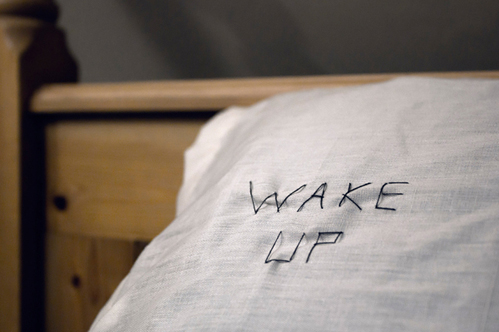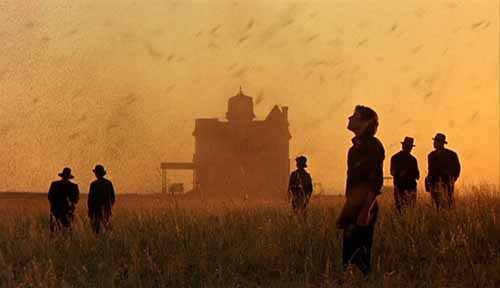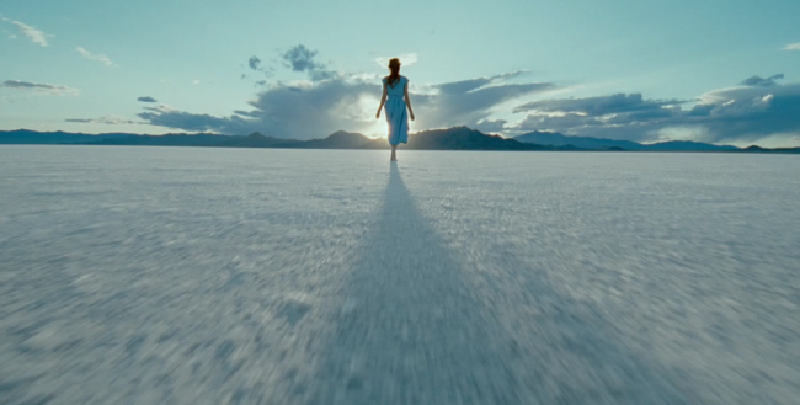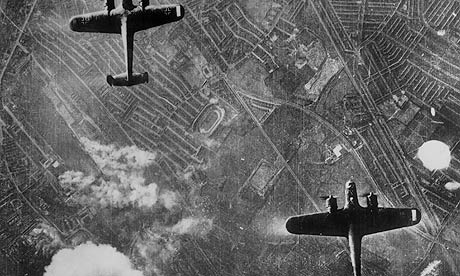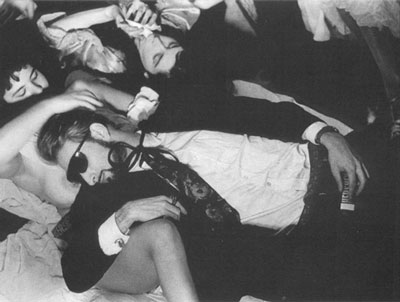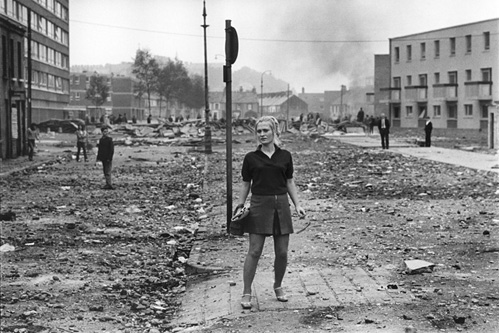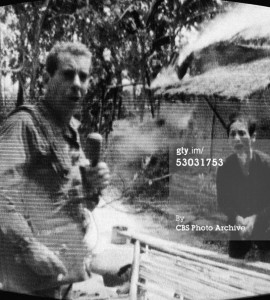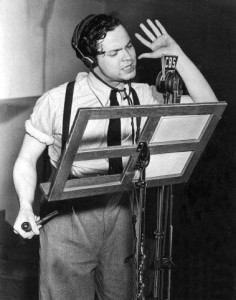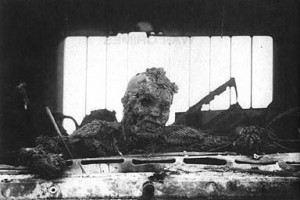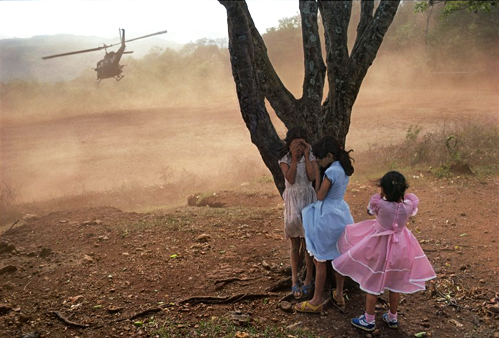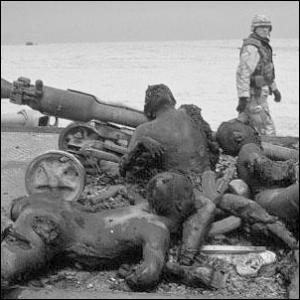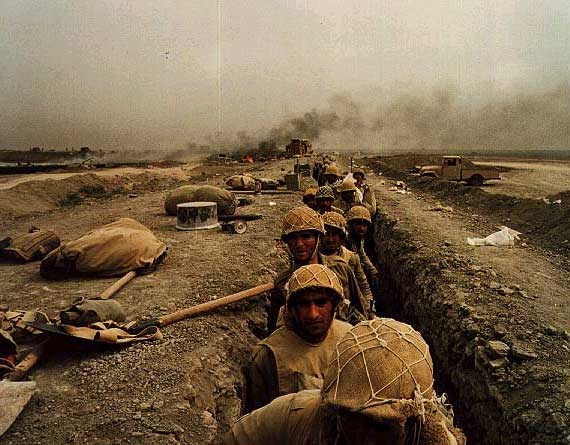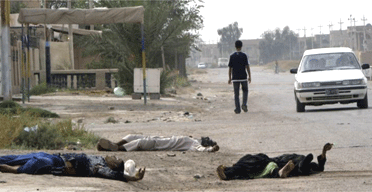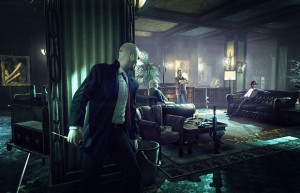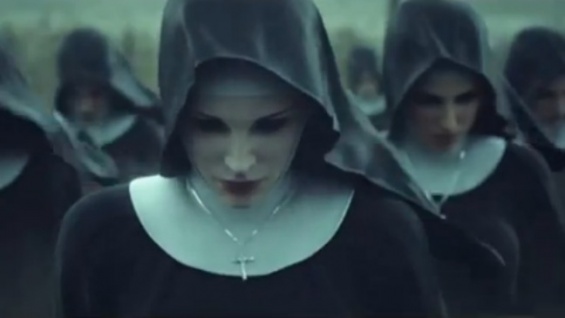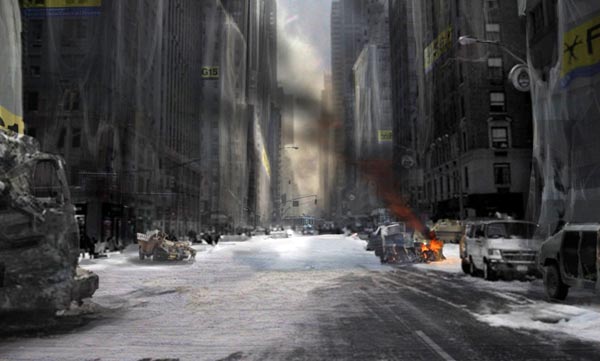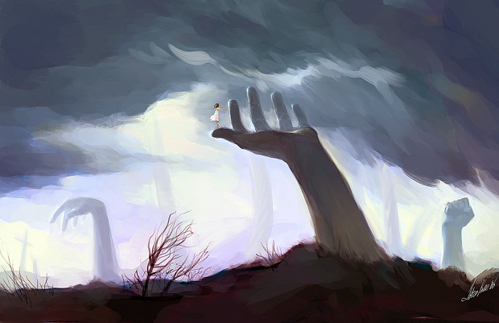
Frequencies: an interview with Jason Boughton
Jason’s practice begins with a long troll through the internet, he is a virtual pirate, a gluttonous fan (is there nothing he is not interested in?), searching for pictures the empire has left behind. In place of the camera, the internet, and once they have come home, regathered their digital parts into movies which he pulls apart and then together, he searches for a way to make them visible again. It isn’t simply a question of re-presentation, of some clever reframing. Instead, he tries to close the door, he looks for a way for these pictures to refuse the viewer, to keep their mystery and demand our approach. Jason’s battleground of pictures refuses the survey look, the pan which maps out territory, the aerial view which designates targets. How very necessary this work is, particularly now, when the divisions of form and content seem larger than ever, when the documentary belongs to television and formal experiments to the art world. So many state terrors have become visible, but few can be seen, except in those instances when time has been re-introduced into the act of looking, when there is time above all to wait for these pictures to unfold, and lay bare the dark secrets that produced these everyday catastrophes.
MH: How did you find the title for The Frequency of the Sun (10 minutes 2005)? Does naming come first, as something to gather thoughts around, or does it occur as an afterthought?
JB: Until recently, I worked by accumulation, images were added to or subtracted from other images until some sense emerged, or until they articulated an argument. Frequency started with a sequence of outtakes from Why We Fight, the American propaganda films made by Frank Capra. Some of those images are still there, but the first assemblies contained many more.
The name came along soon thereafter, when I found a source online for radiographic videos from NASA. There were audio clips as well, low-frequency solar radiation played through a radio receiver. That noise is under almost all of the tape, though it’s mostly inaudible. After the name was fixed, it became a litmus for the other material: did it fit the name, which was also the name of all the parts as well as the whole…
This was during the American war in Afghanistan, and even then the Iraq war seemed a foregone conclusion. It was clear that all of this real and impending violence was totally impractical, that is, it would fail to address whatever the “problem” was, but still it played as a good thing: people seemed to want it to happen because it might be satisfying, not because it would be useful. This was the atmosphere while I was collecting material, and the goal of the video was always to make an argument about the American obsession with ritual violence, this enormous cliché, without actually engaging in the frustrating, spectacular, greatest-generation clichés.
MH: The opening shot is a bravura track through what appears to be a Midwest cornfield, though the preceding title has clearly identified this landscape as Iraq. It is a striking juxtaposition, and carries with it a sense that us and them are somehow the same. Where did you find this shot and why is it so long? Is duration an issue for you?
JB: The misidentification of the first shot is a trick I resort to fairly often, and is less a proposal of equivalence than an opportunity for confusion, like a small pin-prick opening made in the known, through which disorientation can spurt. A large part of my goal in any of these little videos is to sow confusion among the faithful, though I doubt the faithful are ever in a position to see my work.
That first shot is the opening of Oklahoma!, a cold-war era musical about the taming of the American mid-west. The final shot is its’ evil twin, from Terrence Malick’s Days of Heaven. I needed long shots, deep focus, broad horizons, limitless possibilities, and the fact that these two came from major motions pictures at opposite ends of the cold war was an added bonus.
I am often tempted by some fairly extreme durations because cinema comes with a slew of rules and behaviors by which it identifies itself, and exaggerated duration is one of my favorite ways to abuse an audience who thinks it may recognize some of those telltale cinema markings. Not that my own durations are truly abusive: I have only ever referred to strident materialist strategies; the boredom, discomfort, hypnosis. My own work has too many competing intentions to really commit to deadly duration, but someday, I promise, I’ll make something really really long.
MH: How did you decide on the music?
JB: The music in Frequency is there mostly because it’s awful and beautiful at the same time, but the selection was pretty narrow. I wanted all the music to match somehow, and also the structure of the video to be ‘musical,’ that is, taken from a musical form. I picked the Motet, early voice-and-small ensemble arrangements which usually had a sacred function. The lyrics were almost always bits of poetry rather than verses from the bible or sections of the mass, which made them more versatile as to when they could be performed. They have a very loose rhythm and an episodic structure, with each vocal stanza given individual (if interrelated) melodic treatment. They (as well as lots of other things) are associated with early Polyphony, but these particular ones are not that old.
I think the key piece of music in Frequency is Vivaldi’s setting of ‘Piango, Gemo…’ an anonymous poem which describes a heart so broken the only hope for rest is that another greater pain might come destroy the speaker completely. But all three are about powerlessness—the speaker describes their own total brokenness, they surrender to it with very little expectation of mercy.
We came of course under the cover of darkness, the terrain was level and open, it kind of reminded you of a field in Kansas, a farmer’s fields. It was wide open, gentlemen were out there herding cattle and sheep and women were gathering up wood and children were playing. Then we began to hear the voice of children carrying on and talking back and forth… and it was of some concern to me but I really didn’t feel that we were in danger… forming up after the night… that changed suddenly. I got on the radio and called back and told them that we’d been seen. And as we’re on the radio talking, I caught something out of the corner of my eye and there were some children moving along the canal, further back… I think I’ve been seen… These children to the east of us back away from the highway even further behind us, beginning to maneuver on us, and walking in the field around us… migod… There were two girls and a small boy with silenced weapons and the girl screamed. As they came in they would give out a yell, a battle cry like OOOOOO. And the girl screamed, it was terrifying but I can remember feeling inside myself my gosh we’re all going to die here. (voice-over from The Frequency of the Sun)
MH: Who is speaking and where did you find this testimony? What event is the soldier describing? What was it that drew you to this text in particular? It plays over a black and white image of a largely abstract cloud of smoke. Why this text with this image?
JB: The testimony is taken from a BBC radio documentary about the first Gulf War. The soldier is describing a reconnaissance team which was dropped at night in northwest Iraq just after the war began, quite a bit off target, so that when the sun came up they found themselves more or less surrounded by small farms. It is a fairly well known incident; they were pinned down by small arms fire for about twelve hours, until they were able to get air cover (the cluster bombs) and helicopters in to rescue them. The helicopter pilots described hundreds of bodies of Iraqi farmers and soldiers, burned out trucks and more. When I heard the story I had a kind of retching, ‘gain the world, lose your soul’ kind of response. Twelve marines, with only the weapons they could carry plus air strikes, spend half a day killing hundreds of Iraqis and then split without a scratch on them. Wow, this is amazing… but not the story you hear in Frequency. In that one, the Iraqis win, sort of. It is my revenge fantasy because I want my soul back.
MH: Why do we see pictures from the Battle of Britain where England/London was bombed by the Germans during World War Two? What is the relation between this imagery and the cluster bombs of the Iraq war which is described in the voice-over?
JB: The black and white material was taken from Why we Fight. The shot in question is from a camera mounted in the nose of a dive bomber, run in reverse and slowed down quite a bit.
My step father was a child in the Battle of Britain. His hobby was airplane identification, he won some sort of trophy for correctly identifying German planes by their undercarriages. He also spent some time in the tube, waiting for the impacts to stop, and came home one day and found a big hole where his house had been that morning. Later, after having been evacuated to the country, he watched a V2 vaporize the house behind his garden. So in my mind I’m not really comparing the American war machine to the Luftwaffe so much as I am comparing this old man to some Iraqi kid, watching the cluster bombs come down.
MH: America is presently at war (again), this time in Iraq (overtly), and busy organizing hostilities in many other countries. Your movie is, amongst other things, part of a motion picture protest, a venerable tradition in itself, though it is rare that works on the fringe take up overtly political themes. Why is this? And isn’t the exhibition of this work reserved for avant safe houses where it can be sure to play to the converted?
JB: What are the pillars of this tradition? Groupe Medvedkin or Jack Smith? Maybe it is difficult to make political films because the first fight is always against the authority of film itself, the all-consuming eye, the vicious empty spectacle… Godard spent years undermining his own authorship, but he outlived even that.
Any discussion of ‘center’ and ‘margin’ is political; it’s my guess that you coined the term ‘fringe’ by way of reintroducing a political logic into the kind of artistic production you like, as against the neutral and positivistic ‘experimental.’ This sort of thing was called ‘avant-garde’ not very long ago. I understand, though, that the limits of that protest tradition are contested; if Chris Marker’s SLON is one of its pillars, does that mean Jack Smith isn’t? Smith’s work is simultaneously a shattering critique of capitalist desire-production and the production of a shattering desire all its own. I want to imagine a wild and valuable politics at every stage of this kind of making; without help or money, showing it to people who may or may not pay, insisting on the value of something which is productive of nothing, which is without exchange value.
I’m just not sure about the safety of the avant house. Is everyone in there in love with the useless? Video at least has little credibility—no one even notices when it lies, or if they do they don’t revere the lie as much. I’m bold enough to think that few audiences are already on my side, and once they’ve seen the videos, most wonder exactly which side is mine. That’s the goal, anyway.
MH: A Halter of Strongly Twisted Rope. (17 minutes 2005) is your first completed work in many years. It comes after leaving Seattle, settling into New York City, reinventing your professional life as a video editor, falling in and out of love. Why the long distance run between movies? What compelled you, after all this time, to pick up the torch (or do you hold, a la Godard, that seeing movies, writing about them and making them are the same occupation?)
JB: The last thing I did in Seattle was teach a workshop on ‘non-fiction’ filmmaking. I was steeped in a hyper-subjective, American avant tradition, and one day (on your suggestion) I decided that all non-fiction was equally perverse and corrupt, reliant on an over-determined technology of reproduction. This is where I invested whatever excess I had available. Between leaving Seattle and starting Halter I worked on plenty of moving image projects, I just failed to finish any of them. I made a living as an editor on the periphery of television, assisting on a few PBS documentaries and then editing for a corporate video production company. Training and industrial process videos, sales and recruiting tools, every low-rent sort of production short of weddings and bar mitzvahs. Somewhere in there was an attempt at a feature-length, verité style doc about local New York politics, and plenty of abortive art projects. I would like to say that it was all leading up to something, but most of that was just punching the clock.
MH: A Halter of Strongly Twisted Rope. opens in the New York subway, a picture of “home,” but seen through the wire scrims of an electrical conveyance, and the windows of an adjacent train that move past, offering isolating glimpses of a trapped and framed humanity, each of us locked into our own compartment, dreaming alone. Then a woman appears sleeping by the window. Oh, it was only a dream. If there is a central character to be found in this movie, here she is, though she never speaks, and appears in sidelong glances, or at an angle whose particular kind of awkwardness can come only out of intimacy.
JB: Most of the shots in Halter are from a vacation video I took in Egypt, including the train shot, the busted up cars, the hotel, the bedroom, the cemetery. The woman is my girlfriend Gretchen. It’s a travel movie, and those are the things we saw, and those are the people who saw us when we went to Egypt: this tautology is more or less intentional. We learned nothing from the French architecture, we had no experiences in the Coptic cemetery or the Muslim necropolis, the Socialist-era transit system was invisible to us, the radical, post-colonial collapse of signifiers left no impression. It was pretty intense.
MH: The screen blacks out and George Bush Sr. says, “Stop everything.” (and we do, the film stops, there is nothing to look at, only a voice in the darkness). “Say a prayer for our men in uniform who at this very moment are risking their lives for their country and for all of us.” There is something chilling in this voice-over, because even though I’ve seen your movie many times, no matter when I play it the voice is always “correct,” there are indeed men (and women) in American uniforms fighting abroad.
When the image returns we are in a stairwell, a place of passage and vertigo. We hear the voice of Nu Nguyen (from the South Vietnamese militia) and as the camera pans up the stairwell we see that the two people walking (one ascends, the other descends) are moving backwards in slow motion. Why?
JB: At the time, the smallest dislocations seemed the most important. The shots are backwards because “time is going backwards,” from the fictional present of the first shots (Egypt) to the fictional past of the voice-over (Vietnam). It was really as on the face as that. It’s a little hotel in Cairo called Pensione Roma—since that visit I have learned that this is where locals put their European and American friends, because it is cheap and charming in a beat-down sort of way. Like a lot of Cairo it has plenty of colonial era nostalgia going for it, the way I imagine Saigon was in the 1950s. At the time, a woman in a trench coat + Coptic cemetery + Indian funeral music + tales of Vietnamese covert operations, all these seemed to me to articulate something strange and awful and intensely particular. Sometimes, when I watch that video, they still do. On the other hand, the metaphysics got me out of coming face to face with any Egyptians, or the facts of Egypt, a material experience of Egypt (or American foreign policy), during my vacation, with my girlfriend, in Egypt.
MH: The second movement returns us to the cemetery. You walk through it with your camera, it is an American body moving once more through the spaces where foreign nationals are lying dead. Everything trembles as if in response, surfaces ripple, the usual physics no longer apply. Voices accompany this passage, hysterical screams, US soldiers talking about familiar spaces becoming instantly dangerous. Then you present a hazy scene of catastrophe, people are running but from what? In the background a large menacing cloud slowly fills the screen. Reporter Carl Phillips tries to describe the moment but his narration is similarly abstract and indistinct. This scene reminded me of Morley Safer’s rap about embedded reporters and live coverage. He insists that live reportage is useless because reporters don’t have any way of knowing instantly what is going on. “It adds heat but it does not add light,” Safer quipped. At the very end of this scene we see a New York police car, and realize that this catastrophe is not happening “over there,” in other countries, where American violence is a commonplace, but “over here.”
JB: That might be the least expensive link in the chain of association the video tries to build. Carl Phillips is the reporter from Orson Welles’s original broadcast of War of the Worlds, and it is the only accurate voice-over attribution in the piece. Carl Phillips knew exactly what was going on, was attuned to that emptiness, to the uncanny (the shock of the thing which is both familiar and terrifying). Is this moment in Halter making some sort of claim about how truth works, its strange structural relation to fiction? Or is it seeking an equivalence between the fear of the Other which Welles exploited and the one Mohamed Atta enacted? Is that moment a dramatic re-creation of the terror of the Real, the unrepresentable, which can only be described through the fog of the Symbolic? This much is obvious: by the end of that sequence, nothing is clearer, no image more defined than when it started. And the thing Carl Phillips saw rising out of the pit went on to destroy everything in sight.
MH: The third movement finds us in New York: where are we and why is the image slowed down? Is it significant that your shooting describes a circle? Once again the audio is sourced separately from the picture, which is one of the ways in which “politics” is produced, the sound/image relation is reimagined “politically.” Can you talk about the audio which accompanies this scene and why you used it?
JB: The voices over the Empire State shots are American pilots circa 1992, talking about the massacre of Iraqi troops between Basra and Baghdad, which is known as the Highway of Death. The shot itself was originally recorded in the summer of 2001, for use in a corporate recruiting film, some sort of impressionistic reveling in the glories of the big city. It was never used; post production was slated to start in late September, and by that time there were no longer any World Trade Center buildings in the distance, much less investment bank recruiting videos.
The voice at the beginning of section three is Robert McNamara in the mid-1970’s, explaining that the bombing of North Vietnam was ethically acceptable because we could have nuked those little villages, and that would have been worse, right? Bin Laden clearly made the same sort of calculations, about how much force would be enough force, when he was planning the Trade Center attacks, but I hope the video does something more than make this comparison.
MH: You deliver us to New York sidewalks teeming with people, and shift focus from the back end of the frame to those faces closest to the camera. You run this shot backwards and forwards, digitally adding layers of soft focus to ease the transitions. What are we seeing here and why?
The final shot is an airplane flying backwards, as if you want to “take it all back,” retract the endless American sorties flown over other countries in order to bomb them.
JB: I don’t know who’s voice that is giving the patriotic harangue over the street shot. I do know it is a radio recording just post WWI. The shot is more re-purposed corporate-video footage, and the effect was produced in-camera.
Recently I looked at Halter again, after quite a long time and quite a few stabs at new work. For the life of me I can’t figure out why so many of those shots are in slow motion. It all seems like so much unproductive pointing at something outside the frame and away from the things that are in the frame. There it all is, the ugly meat of any elegy; vision-crazed tourists sweating out the observation deck, the Trade Center towers, the handy-cam’s auto-focus going nuts back down on the street.
I think there is something basic wrong with Halter, a sort of misunderstanding between me and the material, between how I wanted to experience the present and what was, or is, representable. What I mean is, the dislocation produced by the motion effect is too small, too familiar, fails to ask a question. I no longer wonder if something in particular is revealed in those attenuated intervals, rather, I wonder if there is anything to reveal at all. Aren’t the motion effects a mystification of that emptiness? Wouldn’t it be better to see the tourists looking, and then see the camera looking? There is no image I could record that would ever be an image of a thing, more than a thing itself, so all that manipulation seems to obscure what was actually there—a building before the building was gone, a mass of anonymous desires, the slow grinding of the auto-zoom, all looking. I’ve started hunting around for the source material—maybe it will be revised entirely, same shots in the same order, in real time, the voice-over and music trailing out over black.
We had a phone conversation a few weeks ago—it was late and raining, and I had just finished fucking up yet another freelance editing job. We talked about Ken Jacobs’ epic length Tom Tom, the Piper’s Son. You seemed to suggest that the point of all that temporal atomization hung on some mystery revealed. Did I understand that correctly? Is there more than just the physical affect—wouldn’t just staring at landscape passing from a train window produce the same value? And is that enough? My point is: I no longer wish to transport any viewer to a place of contemplation.
I guess you need to see my flicker movies. They are fucking punk rock, the farthest from formal things, flailing acts of psychic violence, horrible frontal-lobe-burning, cock-thrusting death fantasies, more along those lines. This is my way of approaching the Godard/Farocki demand: to enact metaphysics rather than just speak them, and then speak under meaning instead of at it, without presumptions of authority, in weakness. It is the Lacanian Real, the Gap, the Shift, not the Thing but the space between us and the Thing. Fuck yeah.
How was Christmas with the family? Or did you stay in the arms? Was Christ born again? Was he huge and shining, brilliant and horrible, did the wet little babe force his love on you, empty you of questions? I know you are not as enamored of all that shit as I am, the horrid little tyrant Jesus, but we did have a bit of fun at the homily this year. The super-gay priest read a bit of poetry by Kenneth Rexroth which compared the gifts of the Three Kings to the act of carnal love—”Frankincense like tangled hair, Myrrh like entwined limbs”—sort of thing. I think he was trying to illustrate the complicated tools which God uses to do his work, even the mighty need to shit and fuck but the meek have all the cards anyway. Rexroth was an anarchist womanizer but the folks in the pew were too sleepy to notice.
Just back last night from the long holiday adventure back in the north west. My giant family is wonderful, really, a mess of labour and difficulty and sincere trying to be together. The cost of this is enormous to them, free flowing bitterness and resentment, but the results are good, they are like a tribe of savages adhering to ancient rules even as the forest is burned down to make way for condos and strip malls. Being with them, every time, is so intense, their presence and love and interest is so aggressive. I don’t know for sure that I could live among them, but the older I get the greater the feeling of loss every time I leave, the more certain I am that my exile is self-imposed.
MH: Do write and tell me what’s been happening now that you’ve entered the liberating confines of Columbia University. I remember when you got the news, we were in that honcho clothing shop when your small phone rang, and something like your future raced into your ears. You had been carrying a tattoo design in your wallet for how many years now, and were going to get that done pronto in celebration. What’s it been like over there, what have you been doing?
JB: That clothing store was Century 21, right across the street from the World Trade Center site. I remember you bought a hot little black shirt, some nipple-piercing show-off number. I love that shirt. And I was looking for Tony Soprano-style golf shirts, my new look, which has only gotten more exaggerated in the past year.
Since then I have been making things pretty quickly, short segments of limited ambition, exercises. Almost all are made with footage of various conflicts in the Middle East, all found on the internet. I have spent hours dredging the web, on bit torrent sites, streaming news pages, bulletin boards, YouTube, etc. There are a few sites dedicated to tracking and collecting war footage of all types, especially the soldier-produced camera/phone footage and the trophy shots of roadside bombs exploding, shot by the paramilitary fighters who plant them.
During all this searching I found eight days worth of selects from a single source, a cameraman embedded with a marine unit during the first siege of Fallujah in 2004. For various hard to explain reasons, most of the location audio is unusable, and like most web video the picture is extremely compressed, but the footage is pretty amazing. It is at once tense and dull, violent and abstract because the enemy has been removed. During six hours of footage only six living Iraqis appear: two women in a basement apartment who are frightened but unharmed, and four men of various ages who cross a street on the fifth day, waving a white flag. None of the soldiers get injured, but every day the city is more fucked up. Debris piles up on the roads, more doors are smashed in, more smoke in the distance. I had the material for upwards of two years before I could think of what to do with it.
So far the soldier footage has turned into three short videos. Empty (6 minutes 2007) is a montage of long, static landscape shots, the sort of thing that might be used as establishing shots, moving closer into more defined spaces and then back out. Most of the audio is room tone from an effects library, and for the most part it doesn’t match the shot in any way. The action in the shots is more a lack of action—sometimes there is smoke in the distance, or trees moving in the wind, or darkness increasing between one shot and the next. Sometimes the surface of the shot seems to be moving, but this is a mirage, it’s just the compressed pixels rearranging themselves from one frame to the next. Otherwise the action is in the visible results of something which has already happened. The city is ruined, walls have fallen, something has burned or is burning but the fire itself is invisible.
The second piece is called Home (:20 seconds, 2007). This is a silent, twenty-second sequence of action shots showing soldiers kicking in, shooting out or blowing up the doors of various buildings. The shots are extremely short, featuring only the moment of impact or explosion.
The longest soldier footage thing is called Movement (16 minutes 2007). Unlike the other two pieces it loops and has no title card. I began work on Movement by stringing out all six hours of footage, and then I deleted all the material without soldiers, or whenever the camera was static or moving sideways or backwards or panning or zooming. That left the camera moving forward—even the slightest pause was cut. Through ruined streets, into broken gates and doors, up stairs, through homes, down stairs, back out into streets, running or walking, always in a long line of soldiers moving forward. The original audio is replaced with slick production sound effects of anything that might make a noise on-screen, mostly footsteps on sand, gravel, tile floors or concrete streets, but also doors opening and closing, metal scraping on metal, and occasionally the sounds of hands adjusting automatic rifles. Once you see a truck drive by and once a tank, so you hear those as well. There is no speaking, no ambient tone, room tone or wind.
MH: The missing enemy, the ruined city, the perpetual war machine marching forwards. How many times have pictures from this war lit up broadcast screens around the world, and how seldom does any sense attach itself to these public communions? Your movies feel like they have been set inside the mirage of “coverage,” but why the abstract sound treatment, allowing us to hear the foley artist at work, generating appropriate (if incomplete) aural accompaniments to these bloody imperial designs?
JB: The embedded shooter made many precise decisions, with results that are experienced as much as known. The static wide shots look just like landscape painting, the set-up shots of forced entry, the endless POV traveling shots are all created for serial digestion. The shots are so well built, there seemed nothing more fact-like than the decisions on the surface; here was a useful, awful contradiction. The added audio work was driven by a similar need for awful contradiction. The surface texture is extremely degraded (because of compression), so it needed a noise that would fight with it in the most subtle way possible. I collected as many footsteps sound effects as I could find, recorded some of my own, spent days and nights placing them and still it isn’t perfect. I’ll make one more session before I send it anywhere. For the first minutes it is hard to tell the sound is fake. Then you think you know, and then you’re not sure. It’s unsettling, maybe just a little horrifying, a little!
A couple of words about the two feature length grabs from 2008, I Am Fucked and HitmanHitman. There is more than a small measure of stridency, of hostility, in both these long things. They are made for installation, not to be presented as cinema but as sculptural objects made from cinema. They are both more-or-less simple games played against the terms of distribution: four pirated copies of Legend from as many sources, unaltered except for the layering, like a cake made from garbage. HitmanHitman is the product of color separation and slight timing changes, also applied to pirated source material. Certainly this is procedural, ‘conceptual’ art at its most turgid, but the I in I Am Fucked, doesn’t refer to me, that is, if it is possible to separate me from the artist-producer of objects of transcendent beauty. Obviously, it is, or maybe it isn’t. I’ve projected them both very large, and pleasure is produced, (had some pretty hilarious critiques as well, folks slowly sucked into this sort of vacuum of sense, quite satisfying). These things can’t really be read, in a way, without knowing how arbitrary the production process was, or how the material was collected, maybe even who the original pirates were. Teenagers in Texas? Chinese entrepreneurs? Website operators in Netherlands? Materialism, as an area of discourse on cinema, or a category of possible maneuver, is not closed off and should still be contested, and these are attempts to clarify what constitutes the material.
I absolutely treasure, even require, the harshest critique you can manage. It is never fun to have someone I admire dislike things I’ve made, but I need to hear about it. I don’t exactly understand your position, but that’s my problem, not yours. These makings are often intended to deny a certain kind of pleasure, and the reason a viewer might not enjoy being denied that pleasure is obvious. And if no pleasure is produced at all, that is a problem. I should have sent along a statement of mission with both long pieces, as they would never be seen without at least a description of materials, much less a full discussion of tactics. We also disagree, I think, about what constitutes ‘politics.’ I am poking around this notion that the political is found in the aspects of a text that propose and position the subject which produces them, in every case, whatever sort of subject that is; defined, dispersed, gendered, authorial, contextual or de-contextualized. The more that those aspects can be described as ‘material,’ that is, based in, or resulting from, real social relations, and resistant to representation, the more politics come into play. This line of investigation, apparently, kills your boner. Many, many boners are killed by this work. When I went in to interview at the Whitney program, the director, Ron Clarke, had a similar (but not identical) response. He said that as far as he was concerned, ‘materialist cinema’ as defined by the classical avant garde, is neither materialist nor cinematic. He wasn’t asking for poetry, but he does maybe need the same affect produced. I thought that was weird coming from him, and honestly I think it’s weird from you as well. On the other hand, I barely understand this direction I’m going in. I do know that these are experiments someone has already done, but I haven’t, and I’m going to continue, and I’m going to send them to you. Deal with it.
MH: I am alternately relieved and mystified. I feel you have gone to a far away country and returned with the kind of booty that resides in intelligence, but the customs are strange and inscrutable to me, and as I try to grope through your explanations, I can feel the heat, but not the light. The aspects of a text which position the subject are material. Yes, I think I understand that. But that these are part of ‘real social relations’ (what are those?) and resistant to representation? I’m sure that it is all palpably clear to you, but I am greeting this with the same puzzled stare I once reserved for Lacan’s diagrams. I have no doubt that his explanations, and yours, need to be exactly as complicated as they are, I just can’t hold it in my hands yet.
But then I was surprised about some of your past takes on Halter and Frequency, which are built a frame at a time with a rare and exacting deliberation and underscored with all that feeling. I am wondering if there is a difference that you perceive between that work and this new set, or whether some larger umbrella has been opened up which can account for both?
Strategies. Perhaps it’s all a question of strategies as you say. Why had I imagined there was a bunch of us in the mud, stopping occasionally to fling some up on the wall where the rest of us would turn and look for a moment before resuming our playpen grope. Perhaps this, too, is a strategy, though it feels more like scratching.
JB: In the case of HitmanHitman and I Am Fucked, they are materialist (and so political) inasmuch as they treat the mode of distribution (of the original material) as a kind of content, something that produces supplementary meaning. And distribution is a ‘real social relation.’ As is piracy. There is lots of other supplementary activity going on; the arbitrary and mechanical methods used to arrive at the end product, etc., but none of that really points to how folks live and interact in the world. The guy sitting in front of the guy with the camera shooting I Am Legend, whose head keeps moving around, and the occasional appearance of Chinese subtitles… that stuff does seem to point to a commercial, social relation. Duration has something sort of materialist about it, in this case the drastic limitations put on that pleasure we were discussing earlier. It’s a small aporia — withholding closure in the gallery setting, a cheap trick — but good for a few laughs. This stuff makes for a complicated kind of authorship, not entirely not subjective, and its materiality makes a politics possible. By ‘resistant to representation,’ I mean, for instance in I Am Fucked; the fact of piracy, and all the weird and destructive relationships it entails, sitting right on the surface, without narrativization, without ‘representation’ taking place. It is the result of certain relations, rather than a description of them. That might be all that is going on there, but even so it might not add up to a good movie.
Just so I can understand, when you say ‘underscored with all that feeling’, what do you mean? When you are watching a film do you imagine a filmmaker sitting in an edit room, thinking to herself: ‘During this sequence I have this feeling, whereas during that sequence, I have this other feeling?’ Or is it that, with more or less success, films produce feelings, and these can and should be ascribed to their authors? I’m asking a serious question, trying to make it not sound sarcastic, because it isn’t. When I made those films I had feelings, but I also self-consciously employed tactics which were meant to produce feelings in the viewer, sometimes not exactly the ones I had. I don’t need to tell you about that, you have taught me more about that than anyone. I also had feelings when I made the newer things. Is cinema pleasure, or art pleasure, for that matter, a direct result of the viewer’s ability or inclination or tendency to experience the same feelings about x or y as the filmmaker? Or some feeling, any feeling… I’m quite sure the answer is yes. Maybe.
MH: your work is drenched with feeling, and yes, it is your feeling, your outrage and anger, your greatly offended moral sense that these imperial ventures are terribly wrong. And instead of sticking a camera in the mirror or someone else’s mirror and having some lookalike shriek it out loud, you have stolen into the archive, giving into at least two of your great pleasures: voyeurism and collecting, and feeling no doubt guilty and outraged about that too, and then biting off little picture chunks and hurling them together until something of the broiling insides are spilling up and over. Perhaps it’s just me, but I never tire of it. You are not producing rants, or one sided screeds. It is political in a sense that I can understand: one person living inside an empire which is busy every day with the business and regulation of torture, oppression, foreign conquest, the exercise of power of the rich against the poor. And from a solitary vantage, you are taking pictures because that is one of the many effluents of the colonial enterprise, and then rejigging them so they talk back, or reveal their origins. The whole enterprise is driven by emotion. Or that’s how it feels from this seat. Are your feelings my feelings? Let’s put it this way: if you didn’t have any feelings, I wouldn’t either. Are most narrative movies designed to orchestrate feelings (more than plot or character or circumstance, but feelings): yes, I think so. And the avant world? Well, feelings are suspect in that place, or should I say, in our home. Feelings should arrive in a necessarily complicated way, couched in parentheses or some ironic double take, or as unintended byproduct of some hardheaded materialist gesture, or so extravagantly overdone that there is laughter inside the tears. Otherwise it’s just greeting cards. Or?
I can’t imagine Halter or Frequency existing without your feelings. HitmanHitman and I am Fucked feel like another world, in part because the feelings are so masked and distended and sprayed across such a large surface that they are difficult to locate. What is on offer, and insists again and again, is an operation at work, a knowing hand, the author/viewer who has been here before me and sat in this seat, and is offering me the view which is left. This view feels abject and exhausted, digitally worn down and degraded, versioned and defocussed.
At the risk of burying my sorry unknowing even further, and hoping again for your understanding and generosity, perhaps I could add this: that it does not strike me as unusual that you would attend an art school in New York, and emerge with strategies, codes, operations, procedures. From my dim peaks over the walls I have built around my small world, I have sometimes observed that these are treasured, and beyond that lies the yellow brick road of the art ‘world’ itself, a place which continues to fill me with question marks and indifference. (Perhaps it is only my short sightedness which imagines that there is a difference between these picture relations, and the picture relations which existed BC (Before Columbia). After all that, I may be expressing only my own preferences and tastes. As you know, I have been leaning into the winds of documentary for some time, and am more and more interested in what ‘real’ people are doing, and yes, the feelings that some of these folks evoke. In my new movie there is an extended scene of a cat dying. There is a little girl talking about how much, like, she misses, like, her dead uncle. Corny and sentimental? Probably. But it drives a stake through your heart, and because I miss my friend Mark, and feel guilty about his suicide, and feel helpless and angry and sad, yes, let the fucking cat die where we can all see it, let the innocents speak and then we can burn it all down and start over. You know?
JB: Now I do feel like we are speaking different languages. I wish I had different means to convey the reasons I have for making certain things. Art-school lingo is boring, and nobody in the real world really speaks that way. Sorry about that. I’m going to continue trying until we have more common ground, with minimal pedantry (here I am blathering about materialism, as though it is something you never heard of, as if you haven’t been watching, reading and making Film as Art for 20 or so years). Still, we don’t appear to mean the same things when we use terms like ‘tactics,’ ‘strategem,’ maybe even ‘performance.’ For instance, when I asked what you meant by ‘feeling,’ I should have started out by making clear that I do believe that movies can and should be felt, that feeling is a reasonable and valid criteria for making decisions about movies. Eisenstein wrote that the particular power of cinema is its ability to throw the viewer into the bodily experience of an other, and Barthes cites Dreyer’s Vampyr as an example of how effective, even dangerous, that can be. To be thrown into the bodily experience of the undead might involve, however briefly, breaking a viewer’s connection to the living. The demonstration or activation of ‘feeling’ is never or rarely just tactical. Just the opposite. There’s this great book called Shakespeare’s Game which says that the plays are built as a series of moves – every action both requires and creates an opening for another action, and crisis happens when stasis takes hold. Hamlet is motivated by the ghost who creates an opening, a rift in how Hamlet himself sees the world, etc. To say something is a tactic isn’t to say that it is cynical, just deeply embedded in relations which are themselves deeply embedded in the ways we know ourselves.
One thing to clarify first off. Making work conspicuously motivated or shaped by theory hasn’t been a catapult to art-stardom, or even notice, for a long while. I’m also sorry if I seem to have disappeared into the ‘art world,’ but I don’t believe I have. I did predict that the things I’ve made lately wouldn’t be your cup of tea. In fact, I sent you nothing for two years, because I wanted to avoid this argument, this feeling that I had to defend myself and my work against your love, and virtuosity. I’ll watch my step in the future, as far as that goes.
I accept your criticism entirely, that
> What is on offer, and insists again and again, is an operation at work, a knowing hand, the author/viewer who has been here before me and sat in this seat, and is offering me the view which is left, which feels abject, exhausted, digitally worn down and degraded, versioned and defocussed.
but it doesn’t seem to contradict
> one person living inside an empire who is busy every day with the business and regulation of torture, oppression, foreign conquest, the exercise of power of the rich against the poor. And from this solitary vantage you are taking pictures because that is one of the many effluents of the colonial enterprise, and then rejigging them so they talk back, or reveal their origins. The whole enterprise is driven by emotion.
Except, possibly, but not convincingly, the “one person… solitary vantage point” part. I could try to describe these same films in terms you might approve of, something about the loss of self as actual crisis, as devastating and somehow compelled, an experience of the real, and also about the rejection of artistic expression as a form of resistance to a hierarchy of knowledge. Which commodifies the inner life as manifest in art, which is the basic unit of the Art World you seem to think I’ve accepted. I think that is as much as I should do. If I did say those things, I would actually mean them, but the performance wouldn’t be fair to either of us, especially me. There are some moments in your notes where you sound actually disappointed, as though I have let down our side, or as though by calling art-making a matter of tactics, nothing real can be said. Do I need to take sides? Do you really need to tell me that you mean, quite deeply, every utterance that flows into and out of your work? Do we need to agree?
Got a new tattoo, A huge north western native sea monster on my right shoulder reaching round to my back. A wild angry monster, an agent of chaos, the blessing of unpredictability. It still hurts.

